Our boat ploughs away northward, heading up the Bosphorus, the 20-mile strait with one shore in Europe, the other in Asia, that both splices and binds this city where two continents meet. We churn past Karaköy, the neighborhood at the mouth of the strait on the European side, where a new cruise ship port is under development, onward past the neo-baroque sprawl of Dolmabahçe Palace, where the Ottoman sultans moved in the mid-19th century and helped bankrupt their empire with their marble-encrusted, chandelier-crammed extravagance.
The air is fresh now; the shores and hills on either side unfurl like movie tracking shots. Behind us, Istanbul’s trademark silhouette assembles in the magenta-stained sunset: the swelling domes and rocket-like minarets of the imperial mosques and their grand prototype, the Byzantine basilica of Hagia Sophia. Some giggling visitors toss bits of simit (sesame-coated bread rings) into the breeze for the squawking gulls to pounce on midair. Bigger public ferries, the majestic vapurs, steam by beneath their iconic yellow-sashed funnels; ahead, a tanker looms up, a gray Ukrainian mammoth bound for Odessa. The muezzins’ cries echo now from the Asian shore, as we sip tea from dainty tulip-shaped glasses. We pass more marble Ottoman palaces and wooden waterside mansions called yalıs, our ferry churning on beneath the sweeping spans of two Bosphorus bridges lit up blue, then red, in the falling darkness. We continue past bustling waterside fish restaurants, hedonistic European-side nightclubs where fashionable Istanbullus flip Ferrari keys to valets, and panoramic Asian-side teahouses where Instagrammers prowl for images like hungry gulls. After about half an hour, it’s properly dark. And here come the evening cruise boats, glowing like giant lanterns ablaze with grooving tourists and locals.
My boyfriend, Barry, and I have taken this ride countless times, but it never gets old. The world’s most magical public transport experience carries us along a route that Jason and the Argonauts sailed in search of the Golden Fleece; today it costs under a buck. The Bosphorus was the reason why in 2007 I bought an apartment here in Istanbul. Barry and I will still sit for hours at our big windows looking out on the strait, spellbound by the shifting parade of water traffic in the changing light and seasons, by the moo of foghorns, by the fogbanks that sometimes roll up like cotton-wool glaciers. We gawk, we tramp the long sahil, as locals call the scenic shoreline roads. And we ferry—as we’ve done tonight to meet our old friend Mehmet Gürs, the chef who owns Mikla, the city’s best restaurant. The boat lurches to a stop in the charmed village of Emirgan, on the European side, a 50-minute ride from the city center. We make our way to a shorefront teahouse where Mehmet waits.
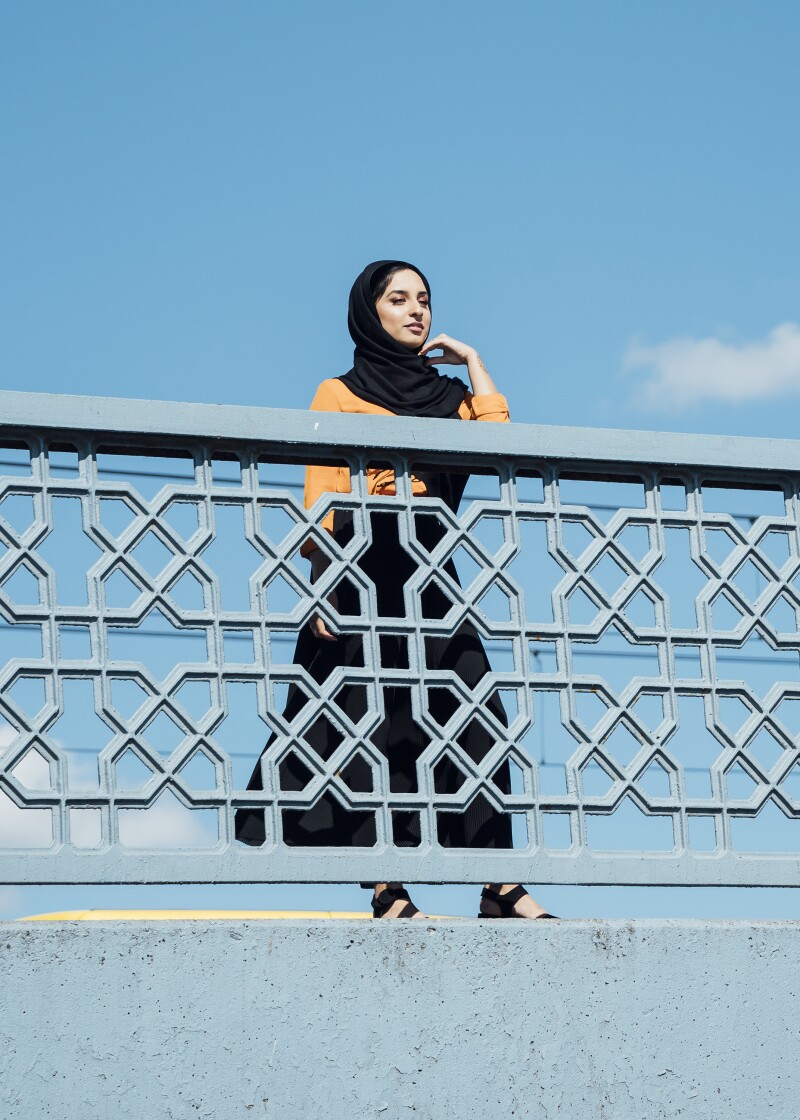
The famous Galata Bridge, located near the main ferry station in Istanbul, spans the city’s Golden Horn, an estuary at the meeting point of the Marmara Sea and the Bosphorus Strait.
Photo by Marco Argüello.
“The Bosphorus? It defines this city, gives it its history!” Mehmet declares over limonata. “The Bosphorus has its own magic, its own ecosystem that cleanses and purifies this city.”
Much has changed since we first got our place in Istanbul. Terrorist bombs rocked the city in 2016; then came a shocking coup attempt. Tourists stayed away, and locals shied from the central entertainment district of Beyoglu. But in the aftermath, once-sleepy residential villages along both sides of the strait have renewed their role as the soul of the city, becoming focal points for a new community spirit. Out on the Bosphorus, the feeling is palpable.
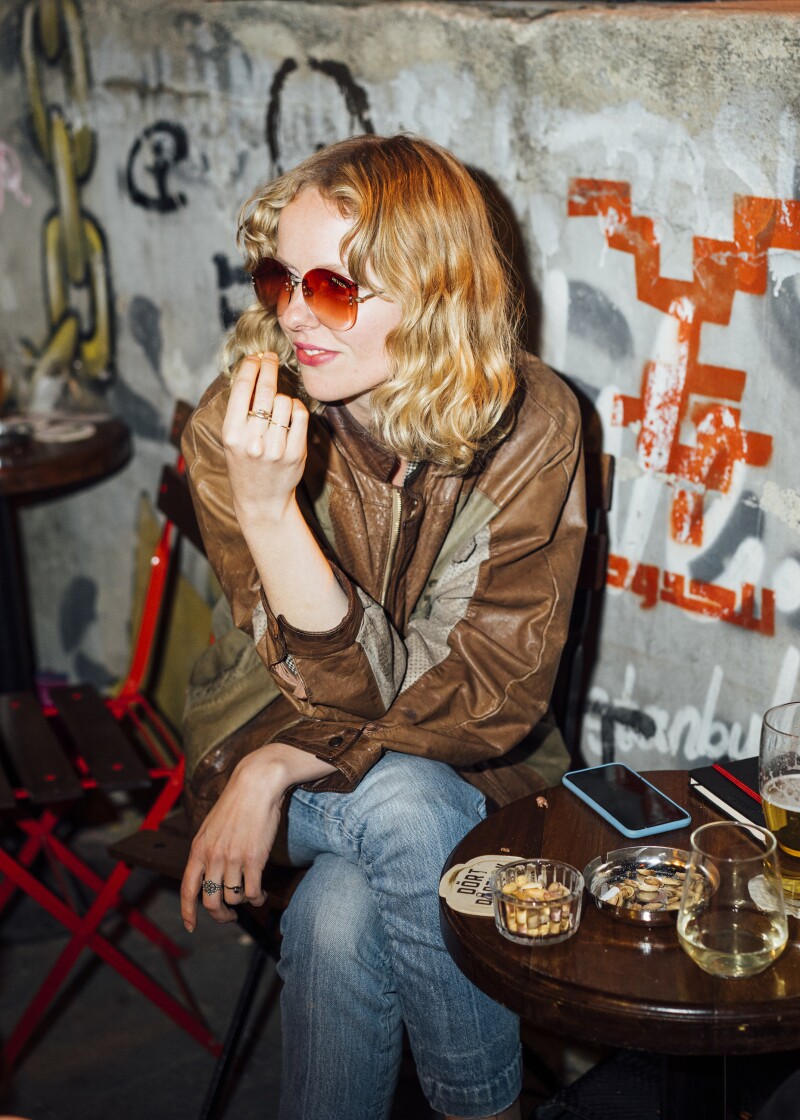
Saturday night drinks on Istanbul’s European shore.
Photo by Marco Argüello.
The debate about which is better—European or Asian shore—is as anchored in Istanbul life as the rivalry among its three big soccer clubs. “Greener! Hillier! More residential!” proclaim Asia proponents. “More cosmopolitan! The nightlife! The grand hotels! The restaurants!” counter the Europe boosters. In truth, both sides of the strait reveal different parts of the city’s essence. Üsküdar, one of the Asian side’s most populous districts, has been a working-class, devout Muslim stronghold since the first of Turkey’s internal migrations in the 1970s brought waves of newcomers from the Black Sea and the Anatolian heartland. Even if the chances of finding a glass of wine here are slim, I’m enthralled by the beauty and spiritual weight of historic Ottoman mosques, by the pleasure of picking a perfect lüfer (bluefish) or barbunya (mullet) from a sea of glistening gills at Üsküdar’s small, clamorous fish bazaar.
We find ourselves in Üsküdar one afternoon with white-mustached resident Mustafa Kargili, devouring a milky pudding with a burnt-caramel top at Kanaat, the classic lokanta (restaurant) his Albanian family has owned since the 1930s. An encyclopedic meze display—stuffed vegetables, garlicky dips—crowds its long counter. “There were many meyhane here back in the day,” Kargili says—and smiles at my surprise. “Yes, drinking taverns, right here in Üsküdar!” Kargili’s family came to Ottoman Istanbul from Skopje, in what is now North Macedonia, in 1915, peddled goat milk ice cream from pushcarts, then learned the restaurant trade from Greeks and Armenians, historically Istanbul’s chief tavern-keepers. “At least we’ll always have the Bosphorus,” Kargili says. “No matter what happens, it’s there for all of us! Providing fish, shade, fresh breezes, and endless beauty.”
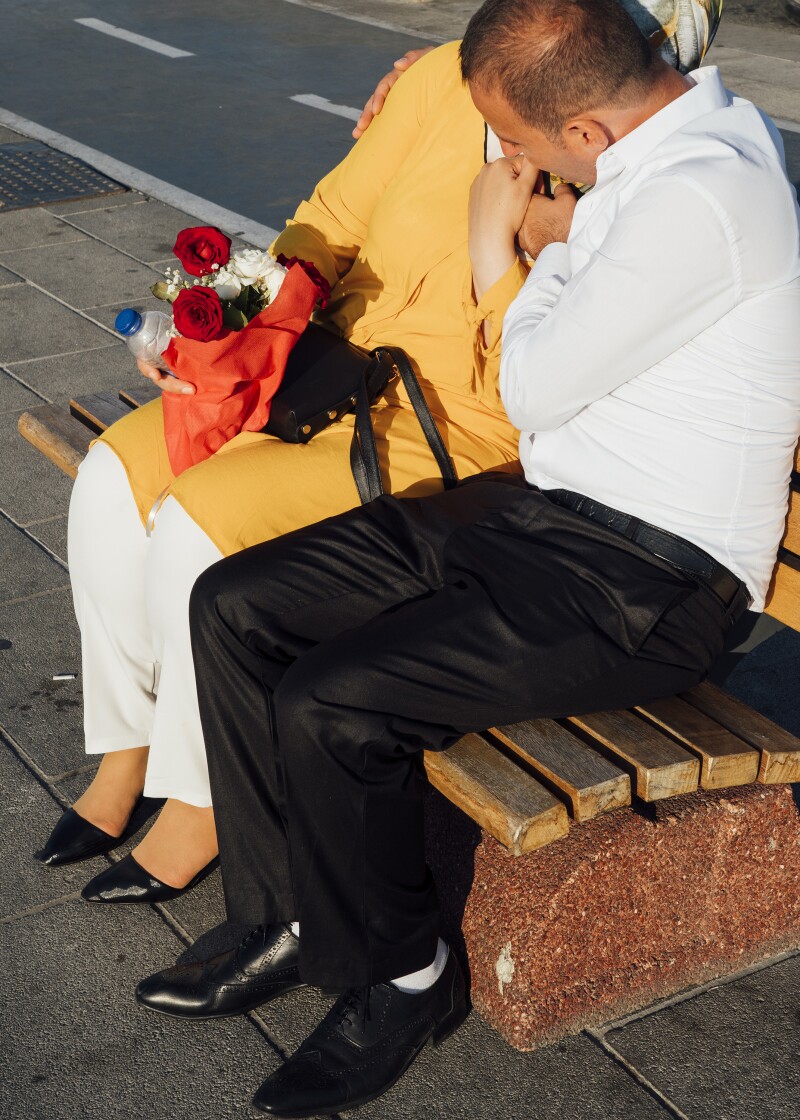
A tender moment on Üsküdar’s main boardwalk.
Photo by Marco Argüello.
We bid Kargili farewell and head off deeper—and steeper—into Üsküdar, led by our guides for the afternoon, Benoît, a Belgian-born longtime expat, and Uğur, a thirtysomething Üsküdar native. A 15-minute climb from the newly pedestrianized pier area brings us to a spot we never knew existed: the slopeside mosque and tomb complex of Sufi saint Aziz Mahmud Hüdayi (1541–1628). “One of the four patron saints of the Bosphorus,” Benoît explains. “Visiting his tomb guards against drowning or dying in fire,” Uğur promises. “How about seagull attacks?” Barry asks. The complex is famous for its cat-loving former imam, who became such a social media celebrity that Japanese tourists and throngs of Istanbullus came looking for him.
If only Üsküdar had rakı—Turkey’s signature anise-scented tipple—we’d be here every night, I think to myself.
Presto. Back down the slope we’re led to a newly refurbished lane boasting not one but two genuine meyhane. Apparently, a drinking subculture survives in Üsküdar. We step into the one called Şadirvan, a photo-crowded shrine to Atatürk, the sartorially resplendent, rakı-loving military leader who founded the modern Turkish Republic in 1923. A life-size cardboard replica of the tuxedoed Atatürk sits in the window at a white-clothed table set with actual rakı and fixings. Benoît translates the placard: “Reserved forever.” On the wall hangs a collection of framed, old wallet-size photos. “Former patrons, happily dead from drink,” the waiter explains, without irony. We fill our glasses with rakı, add water and ice, and watch it turn milky white.
A 20-minute ramble from Üsküdar, a genteel, nostalgic vision of Istanbul arises directly from the shore. Famous as the setting for Sister Perihan, a hit Turkish TV sitcom back in the 1980s about a multicultural, multifaith neighborhood, the cozy village of Kuzguncuk still has a functioning synagogue and Greek and Armenian churches, as well as a mosque. Now, with arty Istanbullus crowding its shabby-chic coffee shops and organic boutiques, Kuzguncuk is enjoying a new heyday.
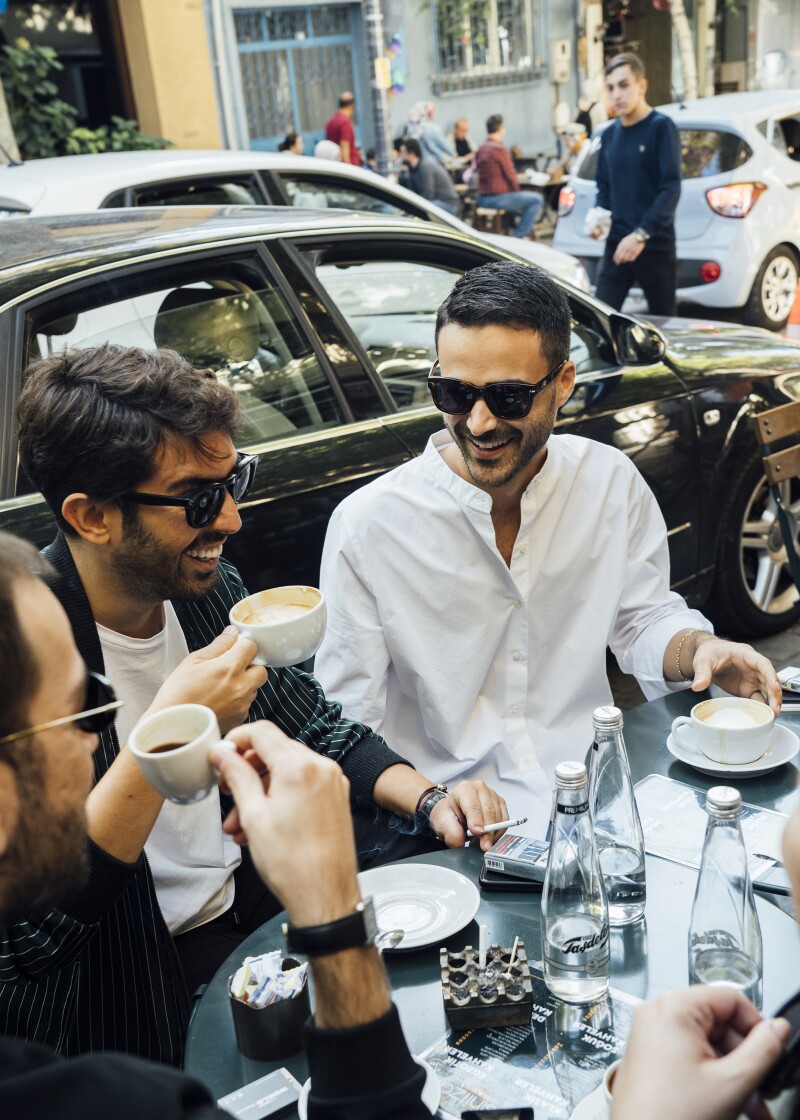
Sunday coffees in Kuzguncuk Village, on the Asian shore.
Photo by Marco Argüello.
“There were only two cafés here back in 2010 when I bought this place,” recalls our irrepressible friend Refika Birgul, a 39-year-old TV cooking star and media comet who lives here and often features Kuzguncuk in her shows. We’re having spicy homemade sucuk sausage sandwiches in the test kitchen of Simotas Binası, the 1923 building that now houses Refika’s burgeoning gastronomy empire. Outside the window, the first Bosphorus Bridge sweeps across into skyscrapered hilltops in Europe. “Simotas Binası was built by a Greek architect for a Jewish family in this, a Muslim country,” Refika explains, “which pretty much sums up Kuzguncuk.”
Refika leads us along the leafy, sloping main thoroughfare, İcadiye Street. Laughter burbles from sidewalk café tables under plane trees strung with colorful lights, and I note girls in stylish Islamic head scarves coolly smoking alongside unscarved millennials with the latest in purple hair frosts. “The non-Muslim minorities are mostly gone now,” Refika says, “but Kuzguncuk retains its unique mahalle [neighborhood] spirit.” Here everyone knows everyone, and you can leave keys for your guests at the grocer’s. Refika is hailed every few yards: by the owner of the Black Sea grocery store, who proffers teaspoons of aromatic wild strawberry jam; by the baker who treats us to mulberry lemonade and dense slices of heirloom-grain breads. Farther on, she points out the “coffee on a hook” icon inside one of the shops. The idea, started by her at one bakery, is for people to leave credit for a coffee for others more needy. Now, Refika says proudly, many businesses have joined in.
“Food unites people,” she muses, selfies done. “Unless we learn to embrace each other, my dear, where is Istanbul’s future?”
Pride of place as community symbol, though, goes to Kuzguncuk’s bostan—a four-acre historic communal garden plot that local residents fought to save from developers. When I last saw it years ago, it was scrappy and forlorn, but now we follow Refika along lovingly kept patches flourishing with leafy greens and zucchini. Kids dart around the modest outdoor movie screen while their parents chat and pick lavender.
“Kuzguncuk has become so popular, the authorities want to pedestrianize İcadiye Street—turn it into a Disneyland,” Refika says. “But as always, we’ll come together, and we’ll fight.” A bunch of young head-scarved fans run up to her, pleading for a selfie. This past Ramadan, Refika, who is secular, made an iftar (the evening meal that breaks the Ramadan fast) on the Bosphorus shore, grilling 400 pounds of chicken and meatballs for several thousand people. “Food unites people,” she muses, selfies done. “Unless we learn to embrace each other, my dear, where is Istanbul’s future?”
Like most Istanbullus, I have my deep attachments to classic Bosphorus food rituals. A briny breakfast parade of cheeses and olives at Kale café on the European side; a buttery börek (savory pastry) bought in Çengelköy village on the Asian shore and carried to the nearby teahouse to watch the flamingo sunset under an 800-year-old plane tree. And of course, the old-school waterside balıkçı, fish restaurants, with their bow-tied veteran waiters.
But recently, many new, chef-centric places have sprung up on the strait’s European shore, and the area is practically exploding with options beyond börek and balıkçı. There are the beautiful salads at Feriye Lokantası, with its eye-level view of a neo-Rococo mosque in the Ortaköy neighborhood; the creative, street food-inspired New Anatolian tasting menu on the panoramic terrace of Alaf, in the up-and-coming Kuruçeşme area; and the buzzy new cocktail bars on the backstreets of the historic Arnavutköy village with its ornate Ottoman mansions.

A spread of snacks and Turkish tea in a private home in the neighborhood of the Rumeli Hisari fortress in Istanbul.
Photo by Marco Argüello.
The community theme we’ve been hearing in Kuzguncuk? It’s echoing at the multilevel Apartıman restaurant, with a dreamy back garden in the gracious European enclave of Yeniköy, an hour north of the center. “Like most Bosphorus villages, this was a one-balıkçı, one-bakery neighborhood with not even a cocktail,” chef and co-owner Burcak Kazdal tells us over her own sparkling cocktails, which are infused with elderflowers just picked in the countryside. “But after the troubles of 2016,” adds her brother Murat, the wine expert who runs the front of the house, “young creatives began to shift away from downtown.” “And suddenly everybody wants to be here in Yeniköy,” Burcak says with a laugh. “We feel like we’re in the center of something—new places open up around us every day!”
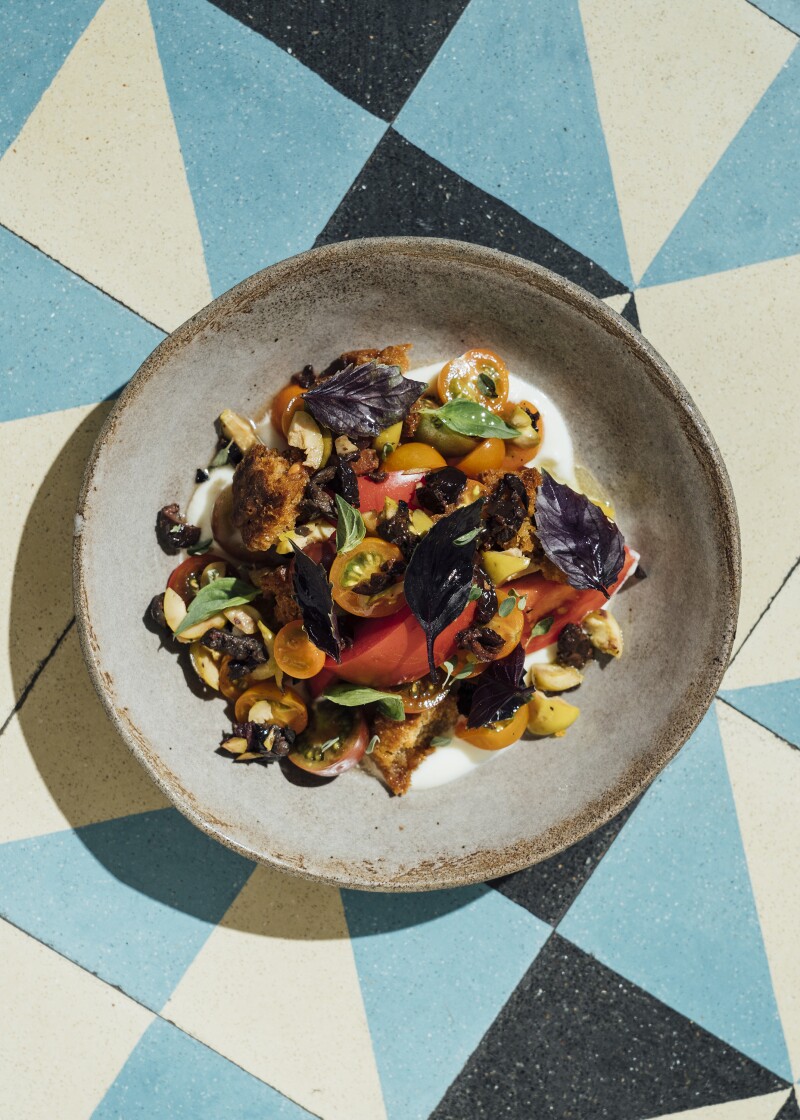
Tomato salad at Apartıman, a restaurant in the Yeniköy neighborhood.
Photo by Marco Argüello.
Apartıman—an apartment building that the Kazdals converted in 2017—is its own kind of community project. Their other brother’s sheep farm supplies the milk for the house-made ricotta and ice cream; friends grow the Spanish-style padrón peppers Burcak expertly blisters. “Our customers include many regulars,” she says: the local bookshop owner, the florist who screens films in her summer garden, the semiretired journalist angling for a rich lady to marry. “Yeniköy is still a village,” Murat declares, as Burcak delivers small plates of tender chard dolmas with mussels and rich fish rillettes with almonds and purslane. “So we wanted to be a true neighborhood spot for Bosphorus people to share with their friends.”
Yeniköy has a particularly fine stretch of restored yalıs, the waterfront wooden mansions built on both sides of the strait as summer retreats by Ottoman aristocracy. For years I’ve been dying to set foot in one. Alas, most are off-limits to mere mortals, hidden away behind walls at street level, and are best admired from the water. And then, kismet! Through a connected friend’s intervention, one afternoon we find ourselves sipping tea from fine china in the intimate waterside garden of a magnificent yalı near a 14th-century Ottoman castle.
The Zarif Mustafa Paşa yalı is the second-oldest yalı on the Asian shore, a splendid, many-windowed white manse I’ve admired from the ferry. “This is a dream of Bosphorus living!” I burble to our hostess, Demet Sabanci Çetindoğan. We eat glistening baklava and gaze past beds of scarlet flowers and dangles of yellow tree blossoms at the sunny breadth of the water, where mussel hunters are diving (completely illegally).
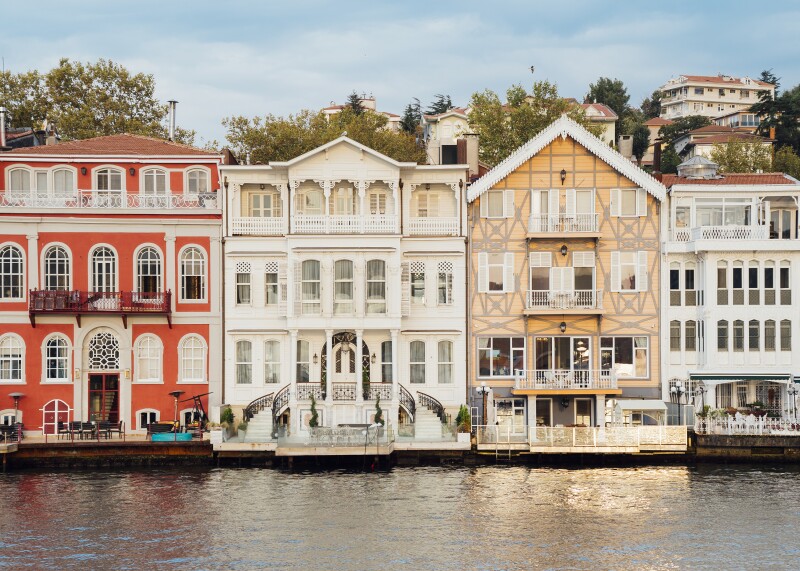
These waterside mansions, called yalıs, can be seen along both the Asian and European sides of the Bosphorus.
Photo by Marco Argüello.
A member of one of Turkey’s preeminent business families, herself a prominent businesswoman and philanthropist, elegant Demet is Turkey’s premier cultural emissary; her yalı has entertained the likes of Oprah and Madeleine Albright. “I wasn’t really into Ottoman history,” she confesses, but after she and her husband bought this yalı in 1999 and began researching its past, they discovered that it once belonged to a 19th-century sultan’s coffee purveyor, who of course had a harem wing. We follow her now to the sumptuous coffee room—featuring a trapdoor where veiled visitors could enter discreetly from their caïques (Ottoman rowboats)—then we go to the stony fragments of a “holy spring” fountain, surviving from a Byzantine monastery. “Some people still swear it heals,” Demet says. Back in the garden, she points out a posse of giggling, shivering boys plunging into the currents from an adjacent public embankment. “The Bosphorus,” she murmurs, “the Bosphorus belongs to us all.”
This wounded but resilient city is turning to its waterbound soul, I reflect later from a suite in the Bosphorus-side Çırağan Palace Kempinski. Barry and I are taking a staycation at this luxury hotel, where the manicured grounds include an actual landmark Ottoman palace. The original palace was completed in 1871 as new quarters for the Sultan Abdülaziz. In 1910 Çırağan burned down; for decades it stood as a ruined husk. Finally, after years of reconstruction, it was reborn in 1991 as part of the hotel, and it is now the place where, according to general manager Ralph Radtke, “every Istanbul belle wants to get married.” Modern-day royals and celebrities have been known to book the entire palace wing with its 11 sultanic suites. (Everyone’s favorite guest? Bono from U2.)
And now, here we are on our own marble balcony, in the main modern hotel wing, uncorking a Turkish boğazkere red, as the eternal Bosphorus theater plays out—the amazing mismatched parade of boats and ships, ferries and freighters, beyond a foreground of a blue infinity pool and the frilly marble arch of Çırağan’s Ottoman ceremonial gate for entry from the water. The burnt-orange moon unfurls a shimmering yakamoz, a moonbeam carpet, across the water to the Asian shore. We take bites of the hotel’s massive chocolate bar, stamped in the shape of the palace, gazing at the actual palace, lit up in the night like a huge, austerely iced vanilla wedding cake.
The next night, the hotel arranges ringside seats at one of those wedding spectaculars: a table by the marble terrace balustrade at Tuğra, the palace’s Ottoman restaurant. Right below us, along the water’s edge, some 500 heavily haute-coutured guests mingle amidst extravagant purple flower arrangements. Fireworks fizz into the night, and then a rock band kicks off. The Turkish pop classics come blasting, and soon we’re up and dancing by our balustrade, a couple of Bosphorus-besotted bystanders tipsy on rakı, as the wedding party heaves in a circle below. On passing boats, people are dancing too, turning the waterway into one great floating nightclub. Empires may come and go, new troubles may arise, but Istanbul’s Bosphorus ever endures and thrives anew.
>>Next: Plan your trip with AFAR’s Guide to Istanbul











